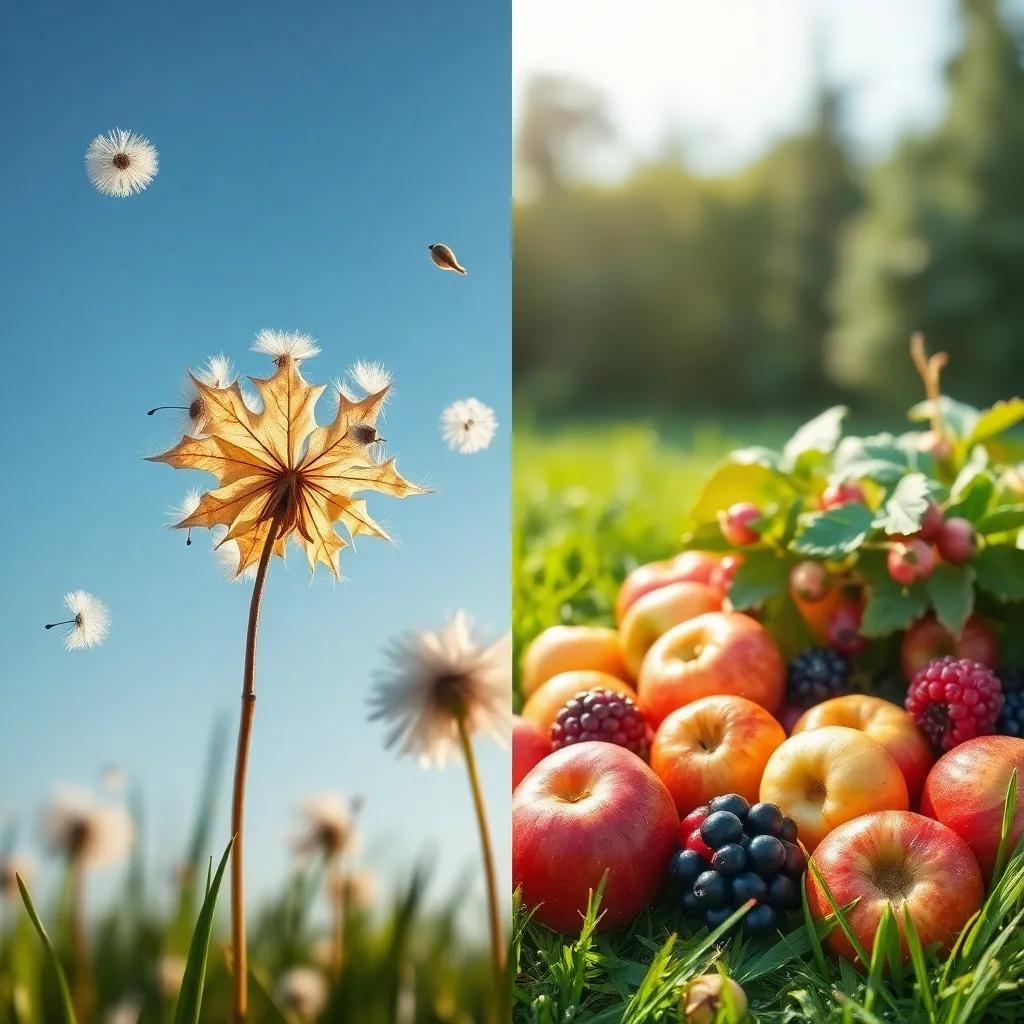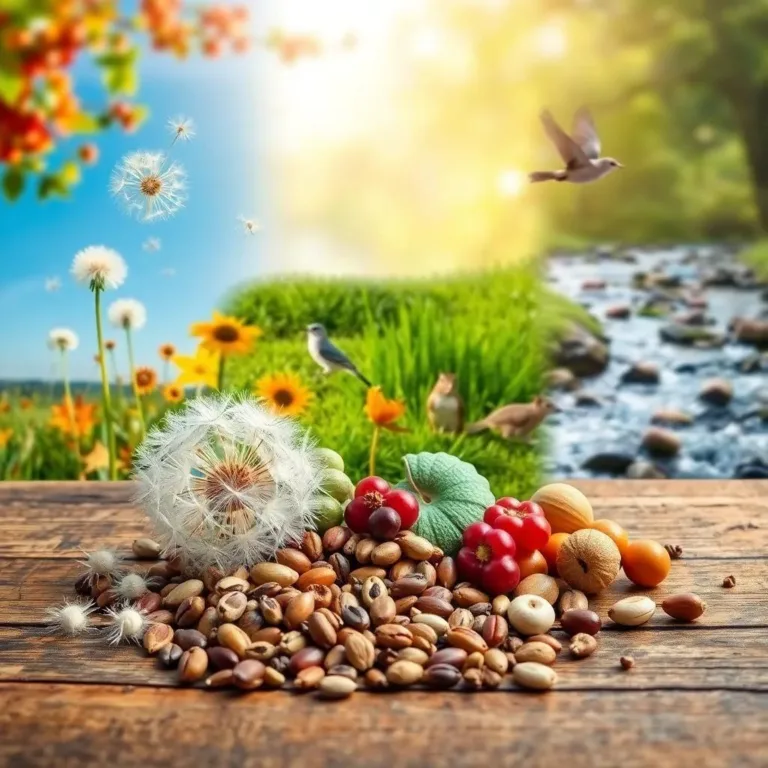Have you ever wondered how plants get their seeds to new places? It’s like a game of tag where the plants are trying to spread out and find the best spots to grow! From flying through the air with the wind to hitching rides with animals and even humans, plants have some clever tricks up their sleeves. Join me as we explore the fascinating ways seeds make their journey to new homes!
Wind Dispersal: Nature’s Airborne Seed Strategy
Have you ever watched a maple seed twirl and spin as it drifts down from the tree? That’s a fun example of how some plants use wind dispersal to spread their seeds! It’s like a little helicopter flying through the air! This amazing method is all about taking advantage of air currents to help seeds travel far and wide.
Plants that use wind dispersal have some pretty cool adaptations. Here are a few:
- Lightweight Seeds: Many wind-dispersed seeds are tiny and light. Think about dandelions! Those fluffy white balls of seeds are carried off by the slightest breeze.
- Wings or Plumes: Some seeds come with special parts that act like wings, helping them float gracefully on the wind. This is what makes the journey much easier for them!
- Large Quantities: To increase their chances of finding the right spot to grow, these plants often release tons of seeds. So, when the wind blows, there’s a good chance at least some will land in an ideal place!
But wait—there’s a catch! Wind can be unpredictable. A seed might end up landing in a rocky spot where it can’t grow at all. Still, the beauty of wind dispersal is that it allows plants to colonize new areas, giving them a fighting chance. I mean, just imagine being a seed, soaring through the sky! Isn’t that a wild adventure?
Overall, wind dispersal is a fantastic way for plants to share their genetic material with the world. It’s nature’s way of promoting diversity and ensuring that life continues to flourish in various habitats!
Animal Dispersal: How Animals Aid in Seed Spread
Now, let’s talk about animal dispersal! This method is just as exciting and involves our furry and feathered friends. Animals play a huge role in helping plants spread their seeds. Can you believe it? It’s like nature’s own delivery service!
Here’s how it works: many plants produce fruits that are super attractive to animals. These fruits are often colorful and delicious, making them hard for animals to resist! When an animal munches on the fruit, it sometimes happens to swallow the seeds too. Here are some important points about this fascinating process:
- Attractive Fruits: Plants use bright colors and sweet tastes to lure animals. Who wouldn’t want to snack on a juicy berry?
- Seed Survival: Some seeds have tough coatings, allowing them to survive their journey through the digestive system. They get a free ride and even a little fertilizer when the animal poops them out!
- Wide Distribution: Animals like birds can carry seeds over long distances. As they fly, they spread seeds across different areas, helping plants colonize new spots.
Think about how squirrels store nuts. They often forget where they buried them, leading to new trees sprouting up! How cool is that?
In summary, animal dispersal is a win-win situation for both plants and animals. Animals get a tasty treat, and plants get their seeds carried far and wide. So, next time you see a bird or a squirrel, remember that they’re not just playing around—they’re helping nature! Isn’t it amazing how everything is connected?

Self-Dispersal: Plants’ Ingenious Method of Seed Release
Let’s talk about self-dispersal! This method is like when a child playfully throws a handful of their favorite snacks into the air. Plants use this awesome strategy to toss their seeds away, all by themselves! Isn’t that clever?
Plants that practice self-dispersal have developed some fascinating tricks to get their seeds to move without any help from outside forces. One of the most exciting ways is through explosive dispersal. Imagine a party popper going off, but instead, it’s a plant bursting its seed pods! When the pods dry out or get a little nudge, they suddenly snap open, sending seeds flying in all directions.
Here are a few key methods plants use for self-dispersal:
- Explosive Mechanisms: Some plants, like the touch-me-not or impatiens, have pods that burst when touched. It’s like they’re saying, “Catch me if you can!”
- Water Dispersal: Certain seeds float on water, allowing them to drift away on ponds and streams. They take a mini vacation while looking for a great place to grow!
- Hygrochasy: Some seeds wait for just the right time. When humidity rises, their pods swell and pop open, releasing seeds when conditions are just right for growth.
By using self-dispersal, plants have more control over where their seeds land. This helps them find the best spots to grow, avoiding competition with their parent plants. So, the next time you see a burst of seeds, remember that it’s just a plant’s way of saying, “Time to spread out!”
Water Dispersal: Seeds Riding the Currents
Have you ever noticed how some plants live near water? These plants often use water dispersal—also known as hydrochory—to get their seeds to new locations. It’s such a smart strategy, and it really shows how plants can adapt to their environment!
So, how does it work? Well, plants that rely on water dispersal have seeds that can float and travel along rivers, lakes, and even during heavy rains. Think of it as having a tiny boat to ride the waves! Here are some cool points to remember about this method:
- Buoyancy: Many seeds have air-filled cavities that allow them to float. This means they can hitch a ride on the water’s surface like a surfboard!
- Attachment to Objects: Some seeds can cling to floating debris, like twigs or leaves. As the current takes these objects downstream, the seeds go along for the ride!
- Reaching New Habitats: When the water recedes, the seeds settle in new locations, ready to sprout in fresh territory. It’s like a plant road trip!
Water dispersal is especially helpful for plants that grow in wetlands or flood-prone areas. It allows them to spread across vast distances and colonize new habitats. Plus, it helps them take advantage of seasonal changes. So, next time it rains, think about how plants are sending their seeds out on little water adventures!
Human Dispersal: The Role of Humans in Seed Distribution
Lastly, let’s chat about human dispersal. Did you know that we humans can be a big part of how plants spread their seeds? It’s kind of funny to think about how we might help plants out without even realizing it!
Plants have become great at using us to their advantage. Here are some ways this happens:
- Cultivation: When we grow crops, we often harvest them and unintentionally spread seeds. Seeds can cling to our clothes or get mixed in with soil we move around. Who knew gardening could be so impactful?
- Gardening and Landscaping: Many plants we introduce to our gardens might escape into the wild. If they produce seeds, these seeds can travel to new locations, sprouting in places we never intended!
- Urbanization: As we build cities and travel, seeds can hitch a ride. They might get stuck in the treads of our shoes or inside our cars. It’s like they’re on a little adventure of their own!
On the flip side, human dispersal can sometimes lead to problems. Non-native plants might spread too quickly and outcompete local species. But when we plant native species, we can help restore ecosystems and promote biodiversity!
So, let’s keep in mind that while we’re busy living our lives, we’re also helping plants spread their seeds, sometimes in amazing ways! Isn’t it wild how everything is interconnected?

